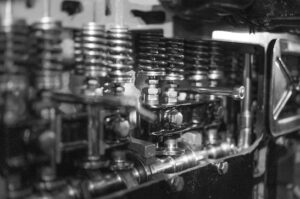 In the design and fabrication of a metal spring, corrosion protection is essential to ensure the application performs as required over its intended service life. The materials selected and the environmental conditions in which the application will function are prime design considerations to protect the spring from corrosion and its harmful effects on the metal and its properties.
In the design and fabrication of a metal spring, corrosion protection is essential to ensure the application performs as required over its intended service life. The materials selected and the environmental conditions in which the application will function are prime design considerations to protect the spring from corrosion and its harmful effects on the metal and its properties.
Stainless steels and other exotic alloys come to mind as obvious solutions to prevent premature corrosion in spring applications. However, some spring applications require carbon steels such as spring steel, music wire, or chrome vanadium that, because they do not hold similar corrosion resistance properties as stainless steel, must be treated with a protective coating to achieve the desired service life.
Rather than substituting one material for another, there are a variety of coatings that offer corrosion protection without changing materials. Carbon steel materials can be galvanized, oil tempered, electroplated, treated with black oxide or subjected to bead blasting. Any of these common coating measures will accomplish desired corrosion protection for a spring. Here’s how:
Galvanize
Galvanized wire springs are made of high carbon steel that is drawn through a series of dies until the material has reached its desired length and thickness. The wire is dipped in a hot zinc solution, effectively galvanizing the material’s surface with a protective coating. The protective zinc coating is resistant to rust and relatively impervious to corrosion. Once the zinc has galvanized to the carbon steel surface, moisture is completely sealed off.
Oil Tempered
Oil tempered springs are made from the same steel wire that galvanized wires are. Once the material has been filtered through a sequence of dies to achieve the proper thickness and shape, the spring wire is run through a number of heating cycles tempered with oil. The process is repeated until the desired tension is reached. Oil-tempered springs are corrosion resistant, strong, flexible and offer long-lasting durability. Because the material has been oil tempered, the springs also have lubricating qualities that help maintain the spring coiling action and render the spring noiseless. In other words, there is no creaking throughout its service life.
Electroplating
Another common application to protect steel wire from corrosion is via electroplating. The process involves coating the surface of the spring steel with a conducting material, essentially depositing a thin layer of another metal by electrolysis to give the metal corrosion resistance. Electroplating binds a positively charged corrosion-resistant metal, such as chromium, silver or, in particular, copper, to produce a film or layer over the steel’s surface. Once the spring steel has been electroplated, its physical properties have changed to provide the corrosion protection required for the application.
Black Oxide
Black oxide treatment is a conversion technique that offers corrosion resistance as well as an aesthetic appearance that may be needed to minimize light reflection or meet certain environmental conditions. Conversion results from a reaction when the steel material is immersed in a high-temperature chemical solution that converts the surface of the material into magnetite, causing the material to blacken in color. The conversion coating provides the steel wire with a surface finish that adds only mild corrosion protection unless or until the black oxide finish is lubricated. This secondary process provides a high amount of corrosion resistance.
Bead Blasting
Bead blasting is an abrasive blasting or sandblasting technique that projects steel shot or glass beads at high speed against a metal’s surface. The beads are shot through a machine nozzle to achieve a specific finish. Blasting provides a consistent matte finish that contrasts well with other highly polished finishes. The process works best to improve the stress corrosion resistance of stainless steel spring wires, causing the material to harden and stress relieve the metal.
Most metals naturally react to oxygen and moisture in the air, in particular, iron and its alloys undergo a chemical reaction that rapidly forms deposits of red rust on the metal’s surface, causing premature corrosion. Corrosion protection of metal springs then ensures the full-service life of the spring as designed. Carbon steel wire and even stainless steel wire can benefit from proper coatings and treatments to make certain your spring is protected from the harmful effects of corrosion.
If you’re looking for metal springs or stamping manufactured with superior corrosion protection look no further than James Spring & Wire. Our facility is equipped with modern high-speed machinery and a highly skilled workforce to produce compression, extension and torsion springs, retaining rings, constant force springs, wire forms, strip forms, and metal stampings.

